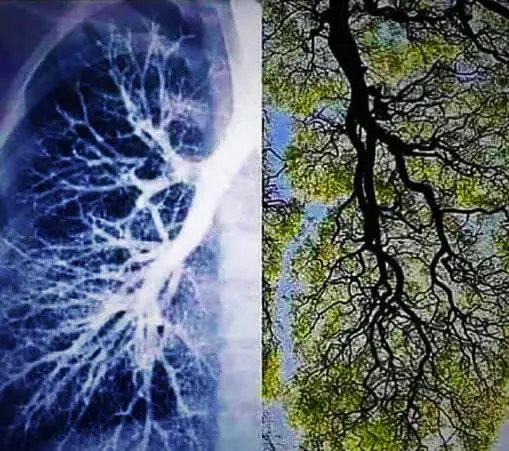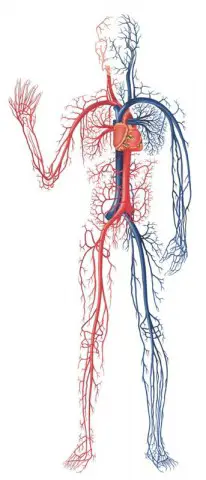Are humans themselves fractals? Well it’s tough to say.
As humans, we’re made up of fractal systems such as our lungs, circulatory system, nervous system, and brain neurons. Our behavioral patterns are also fractal in nature, both as an individual, and from one generation to the next.
The fractal pattern is part of the mathematics of the universe. Fractals commonly appear everywhere in nature, from the tiniest snail shell to the largest galaxy.
Fractals are present on ancient and sacred geometry like the flower of life and also in the frequencies of our musical scales.
In this article we’ll let our curiously explore, as we seek out expert opinions in the field of human fractals.
Let’s Dive In.
What Is A Fractal (A Simple Overview Explained)

A fractal, is a pattern in nature that repeats itself over (and over and over) again, over a period of time.
Due to the repeating nature of fractals, they look similar at both macro (far-away large) scales and micro (close-up small) scales.
Some famous examples of fractal patterns in nature include trees, rivers, lightning strikes, coast lines, and the human nervous system.
Have you heard the term, “as above, so below” ?
This saying is a reference to a fractal pattern, because fractals look similar up close, as they do from far away.
Fractals are a key part of nature. They are all around us. Yet most people are completely clueless to the existence and importance of fractals.
By recognizing a fractal pattern it can give you the ability to understand the present based on the past, and predict the future based on the past and present.
Fractals And Natural Human Biology

Fractals form in nature because of an ancient principle known as “path of least resistance”.
Trees form classic growth fractals with repeating patterns created by the large main branches, repeating themselves in smaller branches, and smaller branches repeating themselves in even small yet twigs, and so on, and so on.
Humans biological systems are more complex, but follow the same natural fractal growth structure as trees and leaves.
Human Lungs ( Respiratory System ) –
In 2020, a new study was published by the Department of Biomedical Engineering at Boston University, which examined the fractal patterns that make up the structure of human lungs.

The lungs are a prime example of a fractal systems within the human body. Nearly identical to tree construction, the lung’s bronchial tubes branch out from your trachea (trunk), to the outer bronchiole (twigs), to the outer most alveoli (leaves).
The study was aiming to develop a deeper understanding of chronic obstructive pulmonary disease (COPD). Ultimately the experts conducting the study found that knowing of the fractal nature of the lung construction may improve our understanding of the underlying mechanisms driving disease progression.
Human Cardio-Vascular (Circulatory) System –

The cardio vascular system delivers blood from the heart to the muscles in arteries, and then returns blood from the muscle, back to the heart in veins.
In 2017, Dr. Gabriella Captur lead a study on the fractal construction of the cardiovascular system, which was published by the National Center for Biotechnology Information.
Dr. Gabriella Captur concluded that the “cardiovascular system exhibits fractal complexity at every level”.
All members of the study believe that a deeper analysis of their findings has the potential to identify patterns of poor heart health in the future. Cardiologists and mathematicians are currently working on fractal math and geometry to expand our understanding of the circulatory system.
Fractal Branching Of Blood Vessels –
At the very end of the smallest veins and arteries ( “twigs” ) are a network of blood vesicles (leaves).

A research paper by Yanguang Chen – Peking University, Beijing – found the fractal property of the blood vessel length, reflects the fractal relationships between blood vessel diameter as well as the drainage volume of a blood vessel.
In other words, blood vessels behaved exactly like every other fractal in nature behaves.
Human Nervous System –

The central nervous system starts at the brain, runs through a ‘main highway’ (trunkline) in the spinal column, and then branches out to the peripheral nervous system from there.
Dr. Andrew Seely lead a study in 2014 looking at the fractal structure of the central nervous system. Dr Seely and his collogues found that there are fractal structures everywhere you look inside the Central Nervous System (CNS).
Fractal Branching of Human Cells –

The key to understanding fractals, is that they always follow the same principles.
“As above, so below”.
Human structures like the lungs, nervous system, and circulatory system all form in fractal patterns, but what are these systems all made up from? Cells.
Human cells make up all of me, and all of you. By following the true natural laws of fractals, it would only make sense that smaller fractals make the building blocks of larger fractals.
For years, researchers have worked long hours to understand the cellular signaling needed to build these intricate bodily fractal structures.
But new research published in the ‘Proceedings of the National Academy of Sciences’, shows that human cells arrange themselves in “”fractal-like branching clusters””. The fractals (patterns in which tiny subsections look the same as the whole) have nearly the exact dimensions as predicted.
The findings could offer insights into the formation of branching fractal structures in the body as well as other key biological processes, said Susan E. Leggett, currently a postdoctoral researcher at Princeton University and the study’s lead author.
Fractal Brains Neurons –

Brain neurons are very similar to other cells in the human body, but much more complex in their abundance.
Physics professor Dr. James K. Johnson says that we know in fractal systems you can zoom in, or out really far, and get the same patterns. “This property is called fractalness — and criticality may explain the origins of widely observed fractal activity in the brain,”
The brain neuron axons (branches) reach out to make connections with the dendrites (twigs) of other neurons.
When a branch of one neuron connects to a dendrite of another neuron, it forms a connection. The more that connection is used the stronger it gets.
In the eyes of experts, it’s the unlimited fractal branching pattern of the neuron’s axons and dendrites that allows them to grow, expand, and communicate with so many other brain cells.
A new study published in 2021 by Dartmouth has found a new way to look at brain networks using the mathematical principles of fractals.
Dartmouth’s study shows that brain networks organize in a similar way to fractal geometry. Dr Lucy L. W. Owen found that patterns of brain networks seem to organize into fractal-like patterns. When those thoughts are disrupted, the fractal patterns become scrambled and lose their integrity.

It’s interesting that when you look at ‘neural brain networks’ at a nano-scale, human city’s at the micro scale, and the cosmos at the macro scale, all look the same and follow the same fractal properties.
Fractals In Human Behavior –
Experts agree that our behavior is a pattern. Fractals are embedded in our lives. The people you date. Your reaction to the situations you find yourself in. The way you take in information, and the way you deal with challenges and stress.

These are all behavioral patterns.
Once you become familiar and aware of fractals, you will start to notice fractals present in different behavioral scenarios.
Personal Fractal Behavioral Patterns –
For example, and for a long time, my ego clouded my perception of the people I dated, the jobs I would take, the way I would react to criticism, and the way I dealt with stress. Letting go of my ego was one decision that had a fractal impact branching out to many areas of my life.
Your behavior patterns affect your mood, mindset, and your overall vibe. Recognizing a fractal behavioral pattern, may uncover other patterns that you’re unconsciously unaware of.
To understand how fractals are embedded in your life, try to notice the pattern of how you consume information, how you deal with relationships, and how you cope with unfortunate events, and how you process and control your emotions.
Look for root causes.
How to Recognize Your Own Fractal Behavioral Patterns ?

Ask yourself why do everything that you do.
Where did you learn that from?
These all are patterns that can be difficult to be self-aware of. It’s much easier to see patterns in other people than yourself. The fractal patterns on our behavior highlight the operating system of humans.
Most people follow the same pattern until they inevitably reach a place where we are forced to change.
Just like fractal growth, we also follow the path of least resistance, even if it’s a behavior that’s not in our best interest, like continuing to smoke cigarettes despite knowing the consequences.
I like to think of “fractal behavior patterns” as the unconscious programs which run in our background, and define the course of action in our lives.
Generational Fractal Behavioral Patterns –

“”As above, so below”” – This is the mantra of understanding fractals, and it also proves true for generational behavior patterns.
Sometimes understanding your behavioral pattern has to “branch out” outside of yourself.
The team of experts at “Wake Counseling” describes ‘generational behavioral fractals’ as personality traits or patterns that are passed down from parent to child. Sometimes they are positive, but often the negative patterns get more attention.
For example, I realized that I’m poor at processing and expressing my emotions.
Then I realized that my parents do the same thing, and so does my grandparents. This inability to process certain emotions is a behavioral fractal in my life that has been unconsciously passed down from one generation to the next.
Changing that about myself is difficult, but becoming aware of it at least gives me the chance to consciously work on it.
Fractals And Human Health –
How can fractals affect human health?

A study published in 2006 by MIT found that incorporating fractals into architecture resulted in lowered stress levels. Other research has found that looking at fractal patterns can reduce stress by as much as 60 percent.
Yet another study conducted by Psychology professor Dr. Branka Spehar, found that surgical patients with rooms that featured views of nature spent less time in the hospital than patients whose rooms faced a brick wall (and as we know, nature contains fractal patterns like trees, leaves, snowflakes, ect).
According to Dr. Richard Taylor, one of the leading experts in the world on fractal patterns, a professor of physics, psychology and art at the University of Oregon, and featured expert on multiple TV documentary series….
“Your visual system is in some way hardwired to understand fractals,”
Dr. Taylor says that “The stress-reduction is triggered by a physiological resonance that occurs when the fractal structure of the eye matches that of the fractal image being viewed.”
Ken Westrick is CEO of TerraMai which is a US company that specializes in bringing the “”Feng Shui“” aspects of nature’s fractal patterns inside homes, offices and business across the country. Ken understand 1st hand and makes a living off of the compelling nature of fractals.
Conclusion:
We’re made of fractal systems, which in turn are made from fractal components. We act in behavioral fractal patterns and are brought up with-in larger generational fractal patterns.
Our universe, our galaxies, our cities, roads, utility-infrastructure, biological systems, and brain connections are all fractals that follow the same principles of ‘as above, so below’.
Although the human body may not be specific fractals on the whole, we’re certainly made up of fractal pieces and completely surrounded by fractals at every level (likely more than we even know).
What are your thoughts about human fractals?
Loved what you read?
Hit that share button and let the world in on the secret – we’d be thrilled!
Got thoughts? We’re all ears for your feedback, corrections, or a good old chat. Don’t be shy; drop us a line.
And hey, don’t miss out on our curated list of must-reads in the recommended books section.
Big thanks for diving in with us today!



